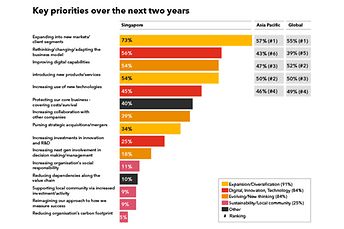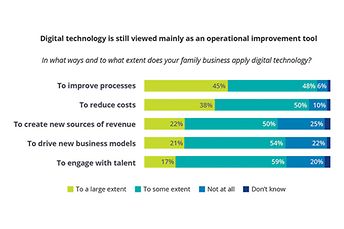How should Next-Gen leaders adopt digitalization in a warehouse operation?
Times are changing for business owners, the environment where businesses are usually ‘normal’ are no longer usual, at least from where the next generation is concerned. In a survey conducted by PWC on the ‘Family Business Survey 2021, Singapore’, it reveals how the new wave of next-gen leaders is motivated to lead their family-owned businesses into a more digitalized state, however, implementation and transformation has been slow.
Taking the pandemic as an additional pressure to drive the adoption of digitalizing a business operation process, more than 50% of the local businesses prioritize expansion into new markets/client segment, rethinking and adapting to new business model, and improving business with digital capabilities as their top three priorities.
To increase the productivity and efficiency of the operation process with minimal efforts, these leaders need to lean towards technology that would push the envelope in striking out mundanity in business processes.

Image source: https://www.pwc.com/sg/en/entrepreneurial-and-private-clients/family-business-survey-2021.html

Image source: https://www2.deloitte.com/sg/en/pages/deloitte-private/articles/next-generation-family-businesses.html
New Markets - E-commerce
Many Next-Gen owners are facing the same issues that bedevil the first generation of business - using a manual business operation/brick & mortar store to approach an Omnichannel Distribution.
In the early 2000s, e-commerce became the gateway for many businesses to increase their market channels, this growth vehicle became more accessible and lucrative ever since 3rdparty online marketplaces are introduced to end-consumers. Since making quick purchases (think groceries to personal care and healthcare products) are now only a click away, many businesses are hopping onto an omnichannel distribution based on instinct. However, the process might be more than just a major decision made at a higher level.
We break down the top requirements to be aware of before designing the operations to accommodate E-commerce fulfilment and how to introduce semi-automated systems in the warehouse operation process without disrupting the existing business operation.
Rethinking/Adapting to new business model – Fulfilment Operations
8 requirements and challenges
SKU Capacity: The capacity to actively store and access considerably more stock keeping units (SKUs) than ever before−up to one million plus in one facility−and to service both e-commerce customers while replenishing brick and mortar stores. In addition, storefronts must be able to adequately accommodate additional SKU selection above and beyond physical inventory capability or that of a regional DC.
Surge capacity: The flexibility to accommodate both daily demand and handle peak seasons. Stores and online orders experience different surges at different time of the year.
Order variety: The need to handle a variable number of pieces per order to support different order profiles for various times of year, including promotions.
Labor constraints: The ability to achieve high throughput in one of the tightest labor markets. It can be extremely difficult in finding and retaining warehouse labor – Invest in creating a more desirable work environment by introducing technology and smarter process to attract better labor.
Prioritization: The capacity and flexibility to handle priority orders that can come in at any time, such as for the customer who pays extra for next-day shipping by noon, meaning the order must go out by 3 p.m. Manually picking the items within the warehouse can put more risk and pressure to the operation.
Flexible and Scalable: Forecasting e-commerce growth is nearly impossible. NextGen solutions must be flexible to change with order dynamics, but intelligent enough to leverage historical data with the capability to scale to meet future demands.
Space constraints: Speculative builds are a frequent requirement for businesses looking to rapidly expand footprint and service. Unfortunately, speculative buildings may not be as straight forward. Businesses needs to retrofit existing warehouse with areas that would allow implementing solution easier.
Stock capacity: Must have the ability to hold 15-20 million units of inventory in active status, to enable the responsiveness and depth needed to make it through major peaks, such as the ‘Singles Day’ volumes.
What type of semi-automated warehouse process would make improvements to the manual systems and support an Omnichannel distribution?
Moving from Manual to a Semi-automated operation
1. Speed up the goods flow process – Modular Conveying System
Keep the goods flowing and put together a foundation for cost-effective processes that involves repetitive procedures and consistent transport paths. Use a modular conveying system for containers, cartons, trays, and products with functions such as conveying, sorting, merging, and diverting as well as storing and buffering would perfectly coordinate the internal process quickly.
2. Goods-to-person principle – Advanced Pick Station
A one- or two-level variants pick stations will increase picking speed by up to 1,000 picks per hour. Orders are picked directly into order bins and cartons with clear operator guidance. Pick by Light and light grid monitoring of the target points would ensure higher accuracy in the picking process and avoid customers returns.
3. Navigate the different work areas and long distances - Automated Guided Vehicles (AGVs)
The navigation of AGVs is optical and based on magnets, triangulation, and SLAM. Since it is also 100% reliable and safe, the fleet controller or manager simply handles the control and optimization of all transport orders. Whether to receive the orders from any warehouse management system or ERP system, the control over the logistics operation can even be centralize in a coordinated manner.
4. Enhance digital capabilities – WAMAS® Software
When automation is introduced into a warehouse, many processes need to be monitored, visualized, and optimized. Orders placed online versus standard orders packed for stores deliveries need to be pick and pack, prioritized and managed according to the delivery commitments with customers. By using a warehouse management software to manage a warehouse operation, receiving, storage, picking, packing, dispatch and even returns can become smoother since human-error is overall reduced.
The Way Forward
As a Next-Gen leader, it is imperative to shift the perspective and recognize how today’s business ecosystems are changing. Outdated process in the operations need to be replaced, failing to proactively capitalize on technology would impede the possibilities for growth and might lose out to competition. Download the ‘Get Ready for the NextGen E-commerce Automation Revolution whitepaper and learn more about the different fulfilment options and technology available.
DOWNLOAD WHITEPAPER HERE
Have more questions about introducing semi-automated process into your warehouse? Contact us for a free consultation to kick start your first step into automation.